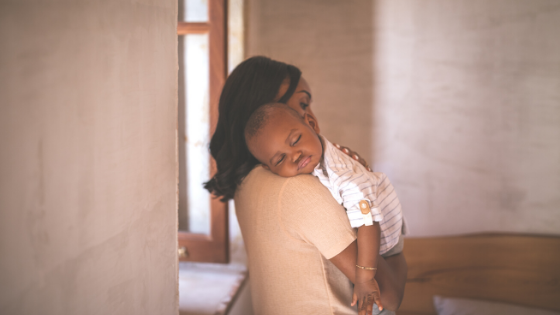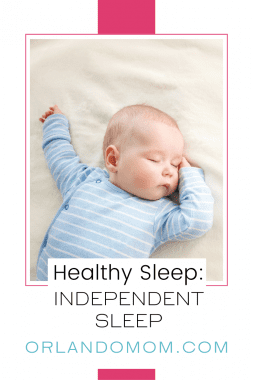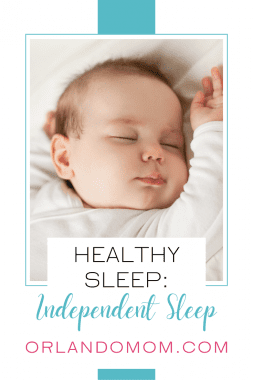
Independent sleep is one of the pieces to the healthy sleep puzzle. Without it you will see sleep struggles. But what is an independent sleeper? AND How do we achieve independent sleep?
Independent Sleep:
Sleep is a skill that needs to be learned. I know, it is one of the most important things we need in life (like food, water and love) – BUT to fall asleep and stay asleep on your own – well, we all need to learn how to do that.
An independent sleeper is one who need nothing to fall asleep and stay asleep on their own. If your baby is older than 4 months of age (from their due date) – they are fully capable of this. It just may take a little guidance from you to get there.
The sleep crutch:
When our little ones first come into our lives, I think some of us are surprised that they don’t always “sleep like a baby,” as the old adage says. Often we are left tired as parents, but our little ones are left tired too! Many of us have ended up using props that end up becoming sleep crutches to help our little one to sleep. But what happens when our little one ends up needing that prop in order to fall asleep and then also needs it every time they wake up?!? Do we wake up at night and keep replacing it? How long will that last? Or should we help them to learn to sleep without it?
Sleep crutches come in many forms. For my first, it was nursing to fall asleep – he could not fall asleep without it. Believe it or not, those sleep crutches end up becoming frustrating for your baby / children. When they feel that they need something to fall asleep, it can start to take them longer to fall asleep and cause more sleep disruptions.
Let’s think about a sleep crutch this way: You go to sleep every night with a pillow or a blanket, right? If you were to wake in the night and let’s say your pillow is gone, what would you do? Personally, I would look on the floor next to the bed to see if it fell off. Then, I might get up and see if I happened to throw it across the room in my sleep. If I still don’t see it, I will need to go to the linen closet or guest room and borrow one. By this point, I am frustrated and more awake. I need my pillow for sleep.

The same is true for your baby or child who needs to nurse to sleep or needs a pacifier to fall asleep. But what can we do about it to help achieve healthy, independent sleep?
Let’s go through our various sleep crutches.
Possible Sleep Crutches:
You:
One of the most common sleep props is YOU (Mom or Dad). I myself became a sleep crutch with our first son, until I decided to work with a Sleep Consultant to help my son learn to sleep without me. It can be nursing, rocking, bouncing or walking. Our intentions are great, cause after all we are just trying to help them sleep, right?
However, if you are doing any of these things, you little one has not learned to fall asleep and stay asleep on their own yet. It may be time to teach him or her that their crib is also a safe and comforting place. You can do this by selecting a method of response without picking your little one up from their crib and then being consistent with that method.
Pacifier:
Sucking is a reflex for babies. It’s an automatic thing that they do and good thing they have this reflex because it helps them to eat. It is naturally soothing and comforting. However, it can lead to an attachment to a pacifier. But what happens if that pacifier falls out in the night or during naps? Do you go in and replace it? How often and for how long do you want to continue this process?
I think the best option on this one is cold turkey. For a younger child you can just stop giving it to them, but for an older child you might consider a creative way for them to part with it. Either case, it may take a few days of getting used to, but with a consistent response from you, the pacifier will soon be in the past.
Swaddle:
The swaddle can be a great comfort tool for newborns, but as soon as they start to roll, the swaddle needs to go. It then becomes a safety issue. There are two ways to do this: 1) Fast 2) Slow.
1) Fast – If you choose to go this way (this is my personal preference) you can help the transition by using a sleep sack instead.
2) Slow – you can un-swaddle one arm at a time, giving a few nights until unswaddling the second arm. Lastly, you would make the transition to the sleep sack.
Milk (Nursing / A Bottle):
What is more soothing and sleep inducing than a full belly? Just think about your latest holiday meal! The issue though, with this sleep crutch is that our little ones tend to become over fed. They can begin spit up more and even show signs of reflux. Try putting your little one on a feeding schedule with food always being after they wake up. The only exception to this rule would be the bedtime feeding, in this case you would want to put the feeding at the beginning of the bedtime routine.
Stuffed Animal / A Doll / Lovey:
Loveys, dolls, stuffed animals may be comforting to a little one in that they have something to hold and hang on to when they sleep. There are even ones out there now that mimic parental breathing and heartbeats (these are a huge hit right now and moms are paying top dollar for them).
Consider the following:
1) Safe sleep
To help reduce the risk of SIDS, your baby should always be Alone, placed on their Back to sleep and in their Crib (ABCs of safe sleep). There should be nothing in the crib other than your baby and the clothes that they are wearing to ensure a safe sleeping environment.
2) Attachment
These could end up being “needed” to go to sleep – what happens if they are lost and not replaceable? Or what happens if the stuffed animal, lovey or doll continuously falls out of bed at night?
I suggest that you don’t put anything extra to your baby’s crib until they are 1 year old. This way you have ensured that they are safe and that they know how to fall asleep on their own.
In removing any sleep crutch or prop, you may see some protest from your little one and it can be tough. Choose a method of response and stick to it. Patience, persistence and consistency will be the keys to success. Your little one does have the ability to fall asleep on their own, if given the chance. But, don’t be afraid to ask for assistance, if you find that you need it.


















